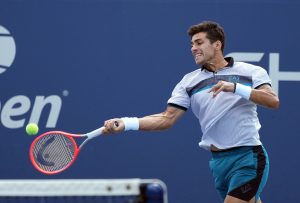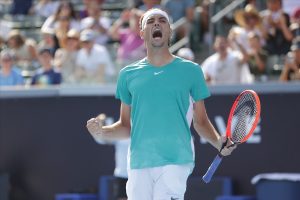They’ve won two Grand Slams apiece, slogged through all the surfaces and the long grind of the pro tennis calendar, but whether it’s Rafael Nadal or Novak Djokovic to end the year on top depends squarely on one tournament: This week’s ATP Finals.
“Squarely” is the perfect word– because we’ve got the bang-up matrix of possible outcomes.
As tennis fans know, the year-end number one is a points race, plain and simple. Nadal is currently in first place with 9,585. Djokovic is in second with 8,945. The distance between them is plenty tight to create a showdown at the ATP Finals, a unique tournament that confers a points bonanza with every match win.
Tennis stats guru Shane Liyanage, founder and managing director of Melbourne-based Data Driven Sports Analytics, put together this fascinating matrix of potential outcomes.

Along the top, you see Djokovic’s possible results, including DNP (does not play), which would mean an early withdraw from the tournament. DNP is an even more distinct possibility for the injured Nadal, who tore an abdominal muscle warming up for his semifinal match at last week’s Paris Masters. Rafa’s outcomes are along the left side of the graph.
At press conference at the O2 in London, site of the ATP Finals, Nadal made his position clear on ending the year number one: “I am fighting for it,” he said.
On the graph, Rafa’s path to year-end number one is represented by orange-colored squares. Novak’s are blue. Clearly Nadal holds the advantage in outcomes.
But that doesn’t mean he holds the advantage overall. Owning more potential outcomes is but one asset in a basket-full of factors. Who has the tougher group? Who plays better indoors? Who’s “feeling it” on his serve this week?
One thing having the scenario-advantage gives Nadal? A cushion.
Let’s look again at the matrix.
Note that the black squares represent outcomes that are not possible. For example, if both players are in the Final, they cannot both win. Nor can they both lose to the other.
Out of 103 potential outcomes, Nadal owns 81 of them. That’s 79%. On the flipside, Djokovic emerges year-end #1 in 22 of the 103 possible outcomes, or 21% of the time.
The ATP Finals is a sticky web of the Top 8 men’s tennis players on the planet, both young guys and the seasoned greats. The format is a two-group round robin, followed by semifinals and a final. Anything could happen.
Liyanage was drawn to the possibilities. “I’ve always been interested in the finer details about tennis, particularly when looking at predicting future outcomes,” he said.
Interestingly, some of Shane’s other predictive modelling involving indoor hard courts gives a slight edge to Djokovic. But just like Nadal’s scenario-advantage, Nole’s surface advantage is only one factor in a sea of many.
Here’s some craziness to consider: Djokovic could win the ATP Final and still not end the year number one. Just look at the matrix. That would happen with 3 round-robin wins by Nadal. That scenario might be vexing for the ATP Tour, but it shows how the early rounds of this tournament are super-meaningful.
A best-case scenario for an ultimate popcorn clash would be this: Nadal makes the final with only one loss in the round robin, while Novak catapults to the final unbeaten. That would set up a single, winner-takes-all final match for the crown of year-end #1.
Main Photo:






